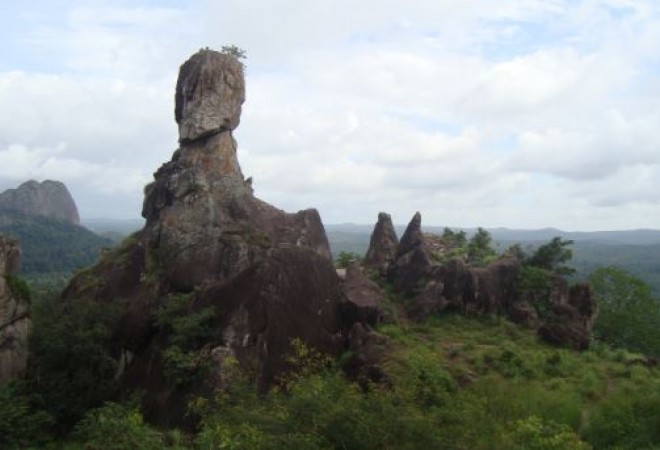
Edakkal caves are nestled within the picturesque Western Ghats of India, the Edakkal Caves stand as a testament to the ancient human presence in the region. Carved into the Ambukuthi Hills in the state of Kerala, these caves offer a fascinating glimpse into prehistoric art and civilization. Spread across two chambers, the caves are adorned with intricate petroglyphs, dating back thousands of years, and serve as an archaeological and historical treasure trove.
The caves were formed through a natural geological process. Over thousands of years, water seeped through crevices in the rocks, gradually eroding and dissolving the softer portions, creating hollows and chambers. Over time, these hollows transformed into the caves we see today. The name "Edakkal" itself translates to "stone in between," referring to the unique formation of a large rock wedged between two others, creating the entrance to the caves.
Also Read: Discover the Enchanting Beauty of Pachmarhi: Must-Visit Places and Attractions
Edakkal Caves are a remarkable repository of prehistoric art and culture. Archaeological studies have revealed that these caves were inhabited by humans during different phases of history, spanning from the Neolithic to the Iron Age. The petroglyphs found within the caves depict scenes from daily life, animals, human figures, symbols, and more. These engravings are believed to have been etched into the cave walls using primitive tools, offering insights into the artistic and intellectual capabilities of our distant ancestors.
The petroglyphs in Edakkal Caves are a treasure trove of information about the lifestyle, beliefs, and culture of ancient inhabitants. Some of the engravings depict hunting scenes, portraying individuals engaged in activities such as hunting wild animals with bows and arrows. Other carvings depict rituals, dances, and processions, providing valuable insights into the spiritual and social practices of that era.
Also Read: Exploring the Charms of New Jersey: A Diverse and Vibrant State
One of the most iconic engravings in the caves is the depiction of a human figure with a raised arm, often referred to as the "dancing man" or "dancing figure." This image has sparked various interpretations, with some researchers suggesting it could represent a shamanistic ritual or a celebratory dance.
Edakkal Caves have also yielded archaeological artifacts such as pottery fragments, stone tools, and ancient artifacts. These findings contribute to our understanding of the technological advancements, subsistence patterns, and trading networks of the ancient inhabitants.
Edakkal Caves are a popular tourist destination, attracting visitors from around the world. To reach the caves, one must undertake a moderate hike through lush greenery, which adds to the overall experience. The ascent to the caves offers breathtaking views of the surrounding landscape and provides a sense of the geographical context in which these ancient marvels were created.
Also Read: Bhutan: A Shining Jewel of the Himalayas
Edakkal Caves stand as a remarkable testament to human creativity, resilience, and the innate drive to express oneself through art. These caves offer a window into the lives of our prehistoric ancestors, allowing us to bridge the gap between the past and the present. Preserving and appreciating these historical gems is not only essential for our understanding of human history but also for the cultural enrichment and education of generations to come.
Also Read: Exploring the Charms and Rich History of Virginia